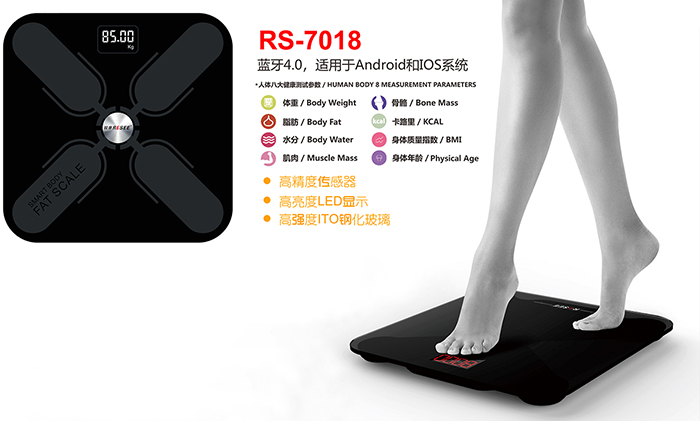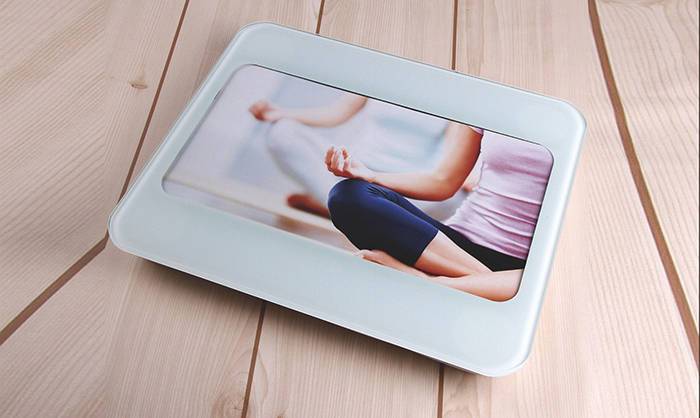Fat weigher scale for Waist Hip Measurement and waist to hip ratio
Body Fat scales were used for waist hip measurements and waist to hip ratio. You can use Body fat scale to measure the minimum waist circumference, usually above the navel, and divide the total by the circumference of the widest hip. If a woman's waist is 28 inches, her hips are 36 inches, her waist circumference is 28 divided by 36 = 0.77. The following is a WHR breakdown of body fat scales measured in relation to the risk of cardiovascular health problems.
Male WHR
Below 0.9 - low risk of cardiovascular health problems
0.9 to 0.99 - risk of moderate cardiovascular health problems
1 or too high - high risk of cardiovascular disease
Female WHR
Below 0.8 - lower risk of cardiovascular health problems
0.8 to 0.89 - risk of moderate cardiovascular health problems
0.9 or above - high risk of cardiovascular disease
A person's WHR is generally considered to be a better indicator of their ideal weight and their risk of developing a serious health condition than a BMI weighed on body fat scale. Various studies have shown that people with large WHRs weighed by large body fat scales have higher health risks than those with smaller bodies with lower WHRs. A fatter person accumulates more fat around the waist, while a smaller person accumulates fat around the hips.
Women with WHR less than 0.8 are usually healthier and more fertile than those with WHR. They are less likely to suffer from diabetes, most cancers or cardiovascular diseases. Similarly, men with a WHR of no more than 9 are generally healthier, more fertile, and less likely to develop serious illnesses or diseases than men with a higher WHR.
Studies have shown that if WHR replaces what body fat scales call BMI as a predictor of global heart attacks, the numbers will include more people.

Body Fat scales, what's wrong with WHR?
WHR can not accurately measure a person's overall fat percentage or the ratio of muscle to fat. However, it is more predictive of ideal body weight and health risk than fat weighed BMI. Waist to height ratio
In a 2015 study, Dr. Margaret Ashville, a former science director at the British Nutrition Foundation, and a team of researchers found that waist circumference was better than height in predicting future heart disease and diabetes risk than BMI, as the body fat scales call it. Keeping half the height of the waistline can help improve the life expectancy of everyone in the world.
Therefore:
Men who are 6 feet tall (72 inches, 183 centimeters) should keep their waistline at 36 inches (91 centimeters) below.
A woman 5 feet 4 inches, or 64 inches (163 centimeters) tall, should keep her waist size below 32 inches (81 centimeters).
The team found that after analyzing several studies involving about 300,000 people, WHR was better at predicting heart attack, stroke, diabetes and hypertension risk than BMI on body fat scales. BMI did not consider fat distribution around the body. Abdominal fat accumulation may be harmful to the heart, kidneys and liver, while fat accumulation around the buttocks and buttocks is less harmful to health.
The researchers add that WHR is much simpler for people to exercise.
"Keep your waistline less than half your height".
How do you measure your waist with body fa

Body Fat scale shows percentage of body fat.
You use the body fat scale to show that the percentage of body fat is your fat weight divided by your total weight, The results show your essential fat and fat reserves.
Essential fat - this is the amount of fat that we need to live, The proportion of women needs is higher than that of men. body Fat scales show that men's essential fat is 2%-5% and women are 10%-13%.
Storage of fat - This includes fat accumulation in adipose tissue, some of which protect our internal organs in the chest and abdomen.
Total fat percentage - this is essential fat plus fat storage.
The United States Sports Commission recommends the following percentage:
Essential fat
Female 10-12%
Male 2-4%
Total fat
The percentage of total fat is divided by body type.
Athletes
Man 6-13%
Female 14-20%
Non athletes are classified as suitable.
Men% 14-17%
Female 21-24 years old
Acceptable
Man 18-25%
Many experts say that calculating the percentage of body fat from body fat scale is a good way to measure their health, because body fat scale is the only way to measure the true body composition. Any male who has a body fat percentage of over 23% or a woman over 30% is overweight or obese.
The percentage of body fat doesn't make a person look healthier than a 100m Olympic champion, just like a BMI.

There are many kinds of body fat scales to measure the percentage of body fat. Neither of them can give 100% accurate figures, but the estimate is considered quite close. Examples include near infrared interaction, dual energy X ray absorption measurement of body fat scales and bioelectrical impedance analysis.
Calculate your BMI (body mass index) using an electronic scale with Bluetooth and WiFi wireless connections, as well as WHR (waist-to-hip ratio) or body fat percentage.
If you start a weight loss program, including exercise and diet, remember that even if your waist may shrink, exercise may increase your muscle mass, which may increase your weight. Muscle is heavier than fat.
For target waist, buttocks and chest measurements may be better. Waist to hip ratio targets are also possible. If you're really focused, check your body fat percentage with body fat scale; if you're not satisfied with reading, talk to a dietitian, sports scientist, or personal trainer about achieving a goal.

Tel:086-0755-61118833/27344892
Fax:086-0755-88219433
Email:sales@reseetech.com
URL:www.reseetech.com.cn、www.reseetech.com
Address:North District,the NO.3 Building, Dapu South Road, Haoer Gangtou Industy Zone, Shajing, Baoan District, Shenzhen
